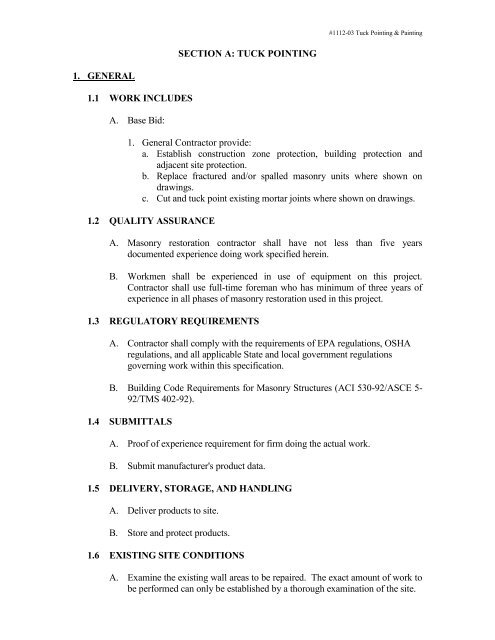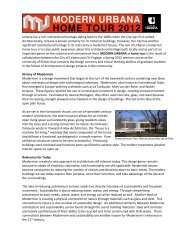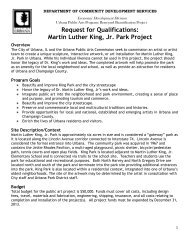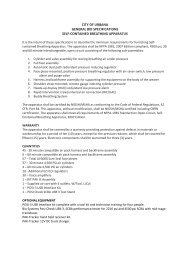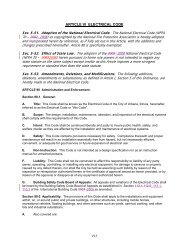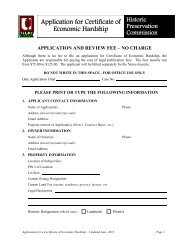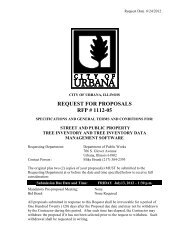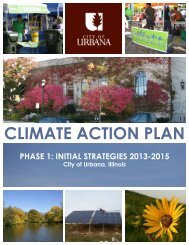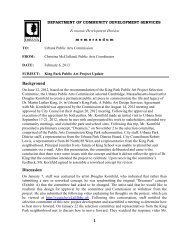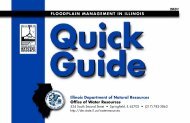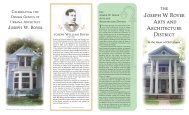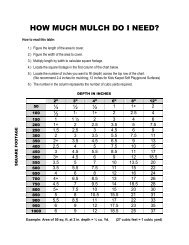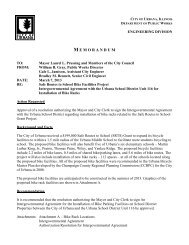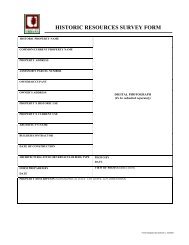Tuckpointing & Painting Specifications - City of Urbana
Tuckpointing & Painting Specifications - City of Urbana
Tuckpointing & Painting Specifications - City of Urbana
You also want an ePaper? Increase the reach of your titles
YUMPU automatically turns print PDFs into web optimized ePapers that Google loves.
#1112-03 Tuck Pointing & <strong>Painting</strong><br />
SECTION A: TUCK POINTING<br />
1. GENERAL<br />
1.1 WORK INCLUDES<br />
A. Base Bid:<br />
1. General Contractor provide:<br />
a. Establish construction zone protection, building protection and<br />
adjacent site protection.<br />
b. Replace fractured and/or spalled masonry units where shown on<br />
drawings.<br />
c. Cut and tuck point existing mortar joints where shown on drawings.<br />
1.2 QUALITY ASSURANCE<br />
A. Masonry restoration contractor shall have not less than five years<br />
documented experience doing work specified herein.<br />
B. Workmen shall be experienced in use <strong>of</strong> equipment on this project.<br />
Contractor shall use full-time foreman who has minimum <strong>of</strong> three years <strong>of</strong><br />
experience in all phases <strong>of</strong> masonry restoration used in this project.<br />
1.3 REGULATORY REQUIREMENTS<br />
A. Contractor shall comply with the requirements <strong>of</strong> EPA regulations, OSHA<br />
regulations, and all applicable State and local government regulations<br />
governing work within this specification.<br />
B. Building Code Requirements for Masonry Structures (ACI 530-92/ASCE 5-<br />
92/TMS 402-92).<br />
1.4 SUBMITTALS<br />
A. Pro<strong>of</strong> <strong>of</strong> experience requirement for firm doing the actual work.<br />
B. Submit manufacturer's product data.<br />
1.5 DELIVERY, STORAGE, AND HANDLING<br />
A. Deliver products to site.<br />
B. Store and protect products.<br />
1.6 EXISTING SITE CONDITIONS<br />
A. Examine the existing wall areas to be repaired. The exact amount <strong>of</strong> work to<br />
be performed can only be established by a thorough examination <strong>of</strong> the site.
#1112-03 Tuck Pointing & <strong>Painting</strong><br />
1.7 WARRANTIES<br />
2. PRODUCTS<br />
A. Warrant for a period <strong>of</strong> one year the masonry repairs against:<br />
2.1 MATERIALS<br />
1. Loss <strong>of</strong> bond between mortar and masonry units.<br />
A. Mortar: ASTM C270, Type N, match existing in color:<br />
1. Water shall be potable, clean and free from acids, alkalies, or organic<br />
materials.<br />
2. Sand shall conform to ASTM C144, and shall be hard, sharp, clean,<br />
well graded, and free <strong>of</strong> organic material.<br />
3. Lime shall conform to ASTM C207, type S, Hydrated lime for Masonry<br />
Purposes. Air entrained lime shall not be used.<br />
4. Cement shall conform to ASTM C150, type II Portland Cement. It<br />
shall not contain more than 0.6 percent alkali to avoid efflorescence.<br />
Air entrained mortar shall not be used.<br />
5. The use <strong>of</strong> admixtures will not be permitted without the prior written<br />
approval <strong>of</strong> Architect/Engineer.<br />
B. Expansion Joint Sealants:<br />
1. Sealant material shall be a one component exterior type urethane nonsag<br />
(gun) grade with elasticity to provide +25% movement capability.<br />
Color <strong>of</strong> sealant shall match existing mortar color. Comply with Federal<br />
Specification TT-S-00230C, Type II, Class A. Acceptable<br />
manufacturers:<br />
a. Tremco, DyMonic<br />
b. SIKA Corporation, Sikaflex-1a.<br />
c. Sonneborn Building Products, Sonolastic NP-1.<br />
2. Backer rod shall be round polyethylene closed-cell foam <strong>of</strong> such<br />
diameter to assure compression when placed, and be compatible with<br />
the sealant selected.<br />
C. Cleaning Agents<br />
1. Acceptable manufacturers:<br />
a. ProSoCo<br />
b. Hydrozo<br />
c. Diedrich<br />
3. EXECUTION<br />
3.1 ENVIRONMENTAL REQUIREMENTS
#1112-03 Tuck Pointing & <strong>Painting</strong><br />
A. Do not lay masonry or stonework, repoint, install sealant, wash down, or wet<br />
surfaces, when temperature may drop below 40 o F within 24 hours.<br />
3.2 PREPARATION<br />
A. Protect existing adjacent windows, ro<strong>of</strong>ing and coping from damage due to<br />
repair operations.<br />
B. Protect elements surrounding the work <strong>of</strong> this section from damage or<br />
disfiguration.<br />
C. Protect parking lot surface, sidewalks below the work area.<br />
D. Protect ro<strong>of</strong> membrane and flashings from damage. Use plywood panels to<br />
protect ro<strong>of</strong>ing from punctures and other damage.<br />
E. Where materials are attached to the masonry (such as ro<strong>of</strong> flashing,<br />
downspouts and collectors, etc) temporarily remove same to sufficiently<br />
allow access to the masonry for required work. Re-attach or re-install at end<br />
<strong>of</strong> project. Provide new attachment hardware where missing, finished to<br />
match existing. Repair to existing condition any damage to such materials<br />
caused by this Contractor, or replace with like kind.<br />
3. 3 REPOINTING<br />
A. Remove existing construction.<br />
1. Remove the damaged or fractured existing mortar joints to a minimum<br />
depth <strong>of</strong> 1", or as much as may be necessary to reach sound material.<br />
Take care to avoid damaging existing masonry units or enlarging width<br />
<strong>of</strong> joints. Mechanical tools such as saws or impact hammers will be<br />
permitted only on specific written approval <strong>of</strong> Architect/Engineer and<br />
demonstrated ability by operators to use without damage to masonry.<br />
2. Repair or replace existing masonry units damaged by cutting, spalling<br />
and chipping caused by routing operations.<br />
3. Thoroughly remove loose material from joints using a hose stream<br />
under normal pressure or by low-pressure compressed air.<br />
4. Repair existing masonry units that are cracked or fractured.<br />
5. Final preparation <strong>of</strong> the joint shall be done by hand.<br />
B. Preparation.<br />
1. Mortar mixing.<br />
a. Mortar should be mixed carefully to obtain uniformity <strong>of</strong> visual and<br />
physical characteristics, and comply with ASTM-C270.<br />
b. Material proportions by volume to produce type N minimum<br />
strength:<br />
1. One part cement, one part lime, 6 parts sand.<br />
c. Thoroughly mix lime, Portland Cement and sand prior to adding<br />
water.
#1112-03 Tuck Pointing & <strong>Painting</strong><br />
d. Add one half the water volume and mix for 5 minutes. Remaining<br />
water should be added in small amounts until desired consistency is<br />
reached.<br />
e. Mortar should be used within 30 minutes <strong>of</strong> final mixing.<br />
f. Re-tempering is not permitted.<br />
C. Filling the joints.<br />
1. After carefully routing and cleaning joints, wet joints thoroughly and<br />
then apply fresh re-pointing mortar. Allow water to soak into joints,<br />
but joints shall not be visibly wet with standing water during tuck<br />
pointing.<br />
2. Fill mortar joints in layers not over 1/4" thick with each layer applied<br />
with pressure as soon as previous layer has partially dried. Do not tool<br />
each layer smooth; leave surface rough to help bond <strong>of</strong> subsequent<br />
layers. Compress the final packing as much as possible to completely<br />
fill joint. Compact joints solidly before final tooling.<br />
3. Tool joints concave to match existing. Take care to not spread mortar<br />
over edges <strong>of</strong> brick onto exposed surfaces. Do not featheredge mortar.<br />
Cure mortar by maintaining in a damp condition for 5 days.<br />
4. Allow mortar to fully harden for 10 days after completion <strong>of</strong> work.<br />
5. Thoroughly clean exposed masonry surfaces <strong>of</strong> excess mortar and<br />
foreign matter using stiff nylon or bristle brushes and cleaning agent.<br />
3.4 CLEANING-GENERAL<br />
A. Promptly as work proceeds and upon completion, remove excess mortar,<br />
smears, efflorescence and droppings.<br />
1. Before cleaning verify that all mortar joints in area to be cleaned have<br />
been repointed and are sufficiently hard for cleaning.<br />
2. Test areas to be cleaned to determine the most effective cleaning method<br />
starting with the gentlest means possible utilizing brush and water wash<br />
at low to medium pressure. If alkaline or acidic cleaning methods are<br />
necessary, mask <strong>of</strong>f areas below to protect finishes that may be damaged<br />
by chemical cleaners.<br />
3. Start cleaning at the lowest designated wall area and proceed to the top <strong>of</strong><br />
the wall always keeping surfaces wet below the area being cleaned and<br />
rinse frequently to reduce the potential for streaking.<br />
4. After the designated area has been cleaned, wash down the wall areas<br />
below.<br />
5. The use <strong>of</strong> abrasive cleaning will not be permitted.<br />
B. Clean adjacent and adjoining surface <strong>of</strong> marks arising out <strong>of</strong> execution <strong>of</strong><br />
work <strong>of</strong> this section.<br />
C. At end <strong>of</strong> each days work, sweep up and remove sand, mortar droppings,<br />
dust, dirt, debris, and rubbish.<br />
D. At completion <strong>of</strong> this work, remove all construction aids and insure that all<br />
sand, mortar droppings, debris, and rubbish have been removed.
#1112-03 Tuck Pointing & <strong>Painting</strong><br />
SECTION B: PAINTING<br />
1. GENERAL<br />
1.1 WORK INCLUDES<br />
A. Paint materials<br />
B. Accessory materials<br />
1.2 DESCRIPTION<br />
A. This work includes the painting and finishing <strong>of</strong> exterior surfaces<br />
throughout the Contract, including surface preparation, priming, and coats<br />
<strong>of</strong> paint specified.<br />
B. The work includes the field painting <strong>of</strong> bare and covered pipes and <strong>of</strong><br />
hangers, exposed steel and iron work, and primed metal surfaces <strong>of</strong><br />
equipment except as otherwise indicated.<br />
C. The work includes restoration <strong>of</strong> existing painted surfaces as indicated.<br />
D. Paint exposed surfaces whether or not colors are designated in any<br />
schedule, except where the natural finish <strong>of</strong> the material is specifically<br />
indicated as a surface not to be painted. Where surfaces are not<br />
specifically identified, paint such surfaces the same as adjacent similar<br />
surfaces.<br />
E. The paint systems specified indicate the basic painting systems.<br />
Deviations within the system, such as the use <strong>of</strong> two finish coats in lieu <strong>of</strong><br />
undercoat and finish, will be permitted only where such procedure is<br />
recommended by the paint manufacturer and approved by the Owner.<br />
F. The work includes the removal and replacement <strong>of</strong> sealant backing and<br />
sealant at all expansion and control joints in concrete masonry surfaces.<br />
1.3 DEFINITIONS<br />
A. The term “paint” as used herein means all coating systems materials, and<br />
includes primers, emulsions, enamels, stain, sealers and fillers, and other<br />
applied materials whether used as prime, intermediate, or finish coats.<br />
1.4 WORK NOT INCLUDED IN THIS SECTION<br />
A. Nonferrous Metal Surfaces: Anodized aluminum, stainless steel, copper,<br />
and similar nonferrous metal materials will not require finish painting<br />
unless otherwise indicated or specified.<br />
B. Operating Parts and Labels:
#1112-03 Tuck Pointing & <strong>Painting</strong><br />
1. Moving parts <strong>of</strong> operating units, mechanical and electrical parts, such<br />
as valve and damper operators, linkages, sensing devices, motor and<br />
fan shafts, and expansion joints, will not require finish painting unless<br />
otherwise indicated.<br />
2. Do not paint over code-required labels, such as UL, FM and WH, or<br />
equipment identification, performance rating, name, or nomenclature<br />
plates.<br />
C. Miscellaneous Surfaces: Rubber and elastomeric sealants, cementitious<br />
firepro<strong>of</strong>ing, and machined surfaces <strong>of</strong> metal hardware and related fittings<br />
will not require finish painting.<br />
1.5 MEASUREMENT AND PAYMENT<br />
A. General<br />
1.6 REFERENCES<br />
1. Paint and related work will not be measured separately for payment,<br />
but will be paid for as part <strong>of</strong> the contract lump sum price for the<br />
work.<br />
A. American National Standards Institute (ANSI):<br />
1. ANSI A13.1 Scheme for the Identification <strong>of</strong> Piping Systems<br />
B. <strong>Painting</strong> and Decorating Contractors <strong>of</strong> America (PDCA):<br />
1. “<strong>Painting</strong> and Decorating Craftsman’s Manual and Textbook”<br />
C. Steel Structures <strong>Painting</strong> Council (SSPC):<br />
1. Steel Structures <strong>Painting</strong> Manual, Volume 2, “Systems and<br />
<strong>Specifications</strong>”<br />
1.7 QUALITY ASSURANCE<br />
A. Regulatory Requirements: Paint products and solvents shall comply with<br />
the latest regulations <strong>of</strong> governing authorities regarding permissible<br />
content <strong>of</strong> volatile organic compounds (VOC).<br />
B. Quality Standards:<br />
1. Paints, enamels, stains, lacquers, and varnishes shall be applied in<br />
accordance with the manufacturers’ latest specifications, instructions,<br />
and recommendations.<br />
C. Paint Coordination:<br />
1. Provide finish coats that are fully compatible with the prime paints<br />
used. Field-applied primers shall be supplied by the same
#1112-03 Tuck Pointing & <strong>Painting</strong><br />
manufacturer as the intermediate (if any) and finish coats used.<br />
Review prime paints to ensure compatibility <strong>of</strong> the coating system for<br />
each <strong>of</strong> the various substrates. Provide barrier coats over incompatible<br />
primers or remove and re-prime as required.<br />
D. Paint Manufacturer’s Review:<br />
1.8 SUBMITTALS<br />
1. Before purchasing paint materials, review the proposed paint systems,<br />
materials, and substrates with qualified representatives <strong>of</strong> the proposed<br />
paint products manufacturer. Obtain manufacturer’s concurrence <strong>of</strong> the<br />
proposed paint systems, or any recommended changes thereto, before<br />
providing product data, samples, and mock-ups specified in Articles<br />
1.8 and 1.9 herein.<br />
A. Manufacturers’ Review: Submit record <strong>of</strong> paint manufacturer’s review as<br />
specified.<br />
B. Product Data:<br />
1. Submit a complete list <strong>of</strong> all materials proposed for use, together with<br />
manufacturers’ product specifications for such products including<br />
backer rod and sealants.<br />
2. No claim by the Contractor concerning the unsuitability <strong>of</strong> any<br />
material specified, or the Contractor’s inability to produce first class<br />
work with such materials, will be considered.<br />
C. Colors and Samples:<br />
1. Colors: The Owner will prepare a Color Schedule with samples for<br />
guidance <strong>of</strong> the painter, and reserves the right to select, allocate, and<br />
vary colors on different surfaces throughout the project, subject to the<br />
limitation that not more than 15 percent <strong>of</strong> bright or deep colors will<br />
be selected.<br />
2. Samples:<br />
a. Before beginning work, prepare for approval a sample <strong>of</strong> each<br />
color, texture and finish required. Such samples, when approved,<br />
shall constitute standards for color, texture, and finish <strong>of</strong><br />
completed work.<br />
b. Make samples 8 by 10 inches in size and upon materials<br />
corresponding with those to be finished on the project.<br />
c. When samples are rejected, a maximum <strong>of</strong> two additional<br />
modified samples may be required, in each instance, to obtain<br />
approval.<br />
d. Approved samples shall be marked for identification and shall be<br />
distributed to the Owner as required.<br />
e. Mock-up for approval <strong>of</strong> final colors shall match the approved<br />
colors and samples.<br />
f. Samples for color and mock-up for sealant backing and sealant<br />
will be required for Owner approval.
#1112-03 Tuck Pointing & <strong>Painting</strong><br />
1.9 MOCK-UP FOR APPROVAL OF FINAL COLORS<br />
A. Final coat <strong>of</strong> paint and finish shall not be applied until the colors and<br />
textures have been approved by the Owner. To accomplish this, the<br />
Contractor shall paint a sample panel <strong>of</strong> approximately 24 square feet <strong>of</strong><br />
the colors and textures selected on every surface <strong>of</strong> the building to be<br />
painted. The Owner will approve the sample panels or direct changes as<br />
desired.<br />
B. The Contractor shall be on the job and be prepared to change sample<br />
panels to colors and textures desired. The Contractor shall notify the<br />
Owner at least three days in advance <strong>of</strong> when sample panels will be ready<br />
to receive approval.<br />
1.10 DELIVERY AND STORAGE<br />
A. Deliver paint materials to the site in original, unopened packages and<br />
containers with labels intact and seals unbroken.<br />
B. Store materials, tools, and equipment in a locked, properly ventilated,<br />
designated storage space on the site, assigned for this purpose. Receiving,<br />
opening, and mixing <strong>of</strong> paint materials shall be performed in this storage<br />
space. Keep storage space neat, clean, and accessible at all times. Protect<br />
areas from paint spillage.<br />
C. Place paint-soaked or solvent-soaked rags, waste, and other materials that<br />
might constitute a fire hazard in closable metal containers and remove<br />
from the premises at the close <strong>of</strong> each day’s work. Take all necessary<br />
precautions to avoid fire danger.<br />
1.11 WEATHER AND TEMPERATURE<br />
A. Surfaces shall be painted only when they are free from moisture. No<br />
painting on exterior surfaces shall be performed less than 72 hours <strong>of</strong><br />
actual drying weather after a rain, or during periods <strong>of</strong> dew or fog.<br />
Receiving surfaces shall be properly dried out before proceeding with the<br />
work.<br />
B. No painting shall be performed when temperature is below 40 degrees F<br />
and above 90 degrees F or when the relative humidity is above 90 percent,<br />
unless recommended otherwise in writing by the paint manufacturer.<br />
1.12 SCAFFOLDING AND PROTECTION<br />
A. Furnish, maintain, and remove all scaffolding, ladders, and planks<br />
required for this work, and all drop Cloths for the protection <strong>of</strong> concrete<br />
walks, floors, adjacent surfaces, prefinished materials, building fixtures,<br />
and similar surfaces.
#1112-03 Tuck Pointing & <strong>Painting</strong><br />
B. Painted and finished surfaces subject to damage or defacement due to<br />
other work in the station or building shall be properly protected and<br />
covered. The Contractor shall be responsible for damage to painted work<br />
and to that other work caused by painting operations under this Section<br />
until final acceptance by the Owner.<br />
2. PRODUCTS<br />
2.1 PAINT QUALITY STANDARDS<br />
A. Paint and painter’s finish shall be the highest quality products <strong>of</strong><br />
nationally recognized manufacturers specializing in the manufacture <strong>of</strong><br />
paint products. Minimum percent solids (MPS) required for the paint<br />
products herein specified shall be as indicated in the following example:<br />
MPS:35.<br />
B. Provide primer and undercoater paints produced by the same manufacturer<br />
as the intermediate and finish coats. Use thinners approved by the paint<br />
manufacturer which meet previously referenced regulatory requirements,<br />
and provide only to recommended limits.<br />
C. Provide primers and undercoaters which are suitable for each surface to be<br />
painted and which are compatible with specified intermediate and finish<br />
paint coats.<br />
D. Materials necessary to complete the painting work are herein generically<br />
specified. Except as otherwise specified, materials for any one paint<br />
system shall be by the same manufacturer.<br />
E. Minimum dry film thicknesses (MDFT), in mils, and the number <strong>of</strong> coats<br />
required to obtain such thicknesses shall be in accordance with the paint<br />
manufacturer’s application instructions and recommendations.<br />
2.2 PAINT MATERIALS<br />
A. Type and Manufacture: The following products constitute the standards<br />
for the primers, intermediate, and finish coats <strong>of</strong> the paint systems herein<br />
specified in Articles 3.4 and 3.5.<br />
1. Ferrous Metal Primer: Alkyd, Anti-Corrosive for Metal<br />
2. Galvanized Metal Primer: As recommended in writing by topcoat<br />
manufacturer.<br />
3. Masonry Surface Conditioner: Acrylic latex masonry filler. MPS:35.<br />
4. Exterior Masonry Paint: Exterior 100 percent acrylic latex masonry<br />
paint. MPS:35.
#1112-03 Tuck Pointing & <strong>Painting</strong><br />
5. Exterior Wood Primer: Exterior wood primer as recommended by the<br />
manufacturer for the location and conditions. MPS:40.<br />
6. Exterior House and trim Paint: Exterior enamelized house and trim<br />
paint for wood and metal, MPS: 40.<br />
7. Enamel undercoat: Alkyd or acrylic latex enamel undercoater. MPS:<br />
35.<br />
8. Semi-Gloss Enamel: Alkyd or acrylic latex enamel, semi-gloss sheen,<br />
washable. MPS: 35.<br />
9. Eggshell Enamel: Alkyd or acrylic latex enamel, eggshell, washable.<br />
MPS:35.<br />
10. Heavy-Duty Glass Enamel: Heavy-duty, industrial grade,<br />
polyurethane, gloss sheen. MPS:45.<br />
B. Accessory Materials:<br />
1. Shellac: ASTM D207, Type I, bleached, No. 4, cut with pure grain<br />
alcohol.<br />
2. Thinner: As recommended by the manufacturer for the respective<br />
product.<br />
3. Spackle or Putty: Standard commercial product manufactured for the<br />
purpose, thoroughly mixed to prevent the possibility <strong>of</strong> shrinkage.<br />
Use exterior grade for exterior Work. Spackle or putty containing<br />
white lead will not be permitted for use on this Project.<br />
4. Sealant Backing: Compatible with substrate and sealant to meet<br />
ASTM 1330.<br />
5. Sealant: Silicone-type, non-staining, non-sag compatible with<br />
substrate to meet ASTM 920.<br />
3. EXECUTION<br />
3.1 PREPARATION OF SURFACES<br />
A. Existing Painted Surfaces to be Painted:<br />
1. Concrete, Masonry, and Stucco Surfaces:<br />
a. Exterior concrete, masonry, and stucco surfaces shall be<br />
sandblasted by the “wet” sandblast method to remove all existing<br />
paint film from these surfaces.<br />
1) When “wet” sandblasting is not permitted by jurisdictional<br />
authority, surfaces shall be selectively power wire-brushed<br />
to remove loose and defective paint film. Edges <strong>of</strong> removed<br />
paint film shall be feathered out to conceal such edges in the<br />
finished work.<br />
b. Surfaces not to be sandblasted shall be properly masked and<br />
otherwise protected to preclude damage to these surfaces.<br />
c. Protection <strong>of</strong> the public and adjacent buildings from the residue<br />
<strong>of</strong> sandblasting operations shall be provided in accordance with<br />
the requirements <strong>of</strong> the jurisdictional authority.
#1112-03 Tuck Pointing & <strong>Painting</strong><br />
2. Wood Surfaces: All wood surfaces shall be power sanded as required<br />
to remove all peeling, flaking, blistering, loose, or otherwise defective<br />
existing paint surfaces.<br />
3. Metal Surfaces: Immediately proceeding power-tool cleaning,<br />
pressure wash and rinse existing painted metal surfaces. Where access<br />
problems or the likelihood <strong>of</strong> damaging adjacent surfaces exist, wash<br />
and rinse. Existing painted metal surfaces shall be power-tool cleaned<br />
in accordance with SSPC-SP 3 to remove loose and defective paint<br />
surfaces, and then feathered smooth. Rust shall be completely<br />
removed. Then solvent clean surfaces in accordance with SSPC-SP 1<br />
to remove dust and apply prime coat <strong>of</strong> Ferrous Metal Primer or<br />
Galvanized Metal Primer, as applicable, to existing surfaces as herein<br />
specified in Articles 3.4 and 3.5.<br />
B. Hardware and Fixtures:<br />
1. Hardware, hardware accessories, plates, lighting fixtures, and similar<br />
items in place shall be removed prior to painting and replaced upon<br />
completion <strong>of</strong> each space.<br />
2. Heating and other equipment adjacent to walls shall be disconnected,<br />
using workers skilled in appropriate trades, and moved to permit wall<br />
surfaces to be painted. Following completion <strong>of</strong> painting, they shall<br />
be expertly replaced and reconnected.<br />
C. Exposed Plumbing, Mechanical, and Electrical Items:<br />
1. Items without factory finish such as conduits, pipes, ducts, grilles,<br />
registers, vents, access panels, and items <strong>of</strong> similar nature shall be<br />
finished to match adjacent wall and ceiling surfaces, unless otherwise<br />
directed. Paint visible surfaces behind vents, registers, and grilles flat<br />
black.<br />
2. Wash exposed metal with solvent, prime and paint as scheduled or<br />
specified. Spray paint wherever practicable. Do not paint concealed<br />
conduits, piping, and ducts.<br />
3.2 PAINT PERFORMANCE AND FIELD QUALITY ASSURANCE<br />
A. <strong>Painting</strong> shall be performed by skilled and experienced painters, working<br />
under the supervision <strong>of</strong> a capable Supervisor. Materials shall be thinned<br />
only for proper workability and in compliance with the manufacturer’s<br />
specifications.<br />
B. Paint material shall be evenly brushed or smoothly flowed on without runs<br />
or sagging, and free from drops, ridges, laps, and brush marks. Assure that<br />
all coats are thoroughly dry before applying succeeding coats. Sand<br />
surfaces between coats as necessary to produce a smooth finish and as<br />
may be required for adhesion <strong>of</strong> succeeding coats.
#1112-03 Tuck Pointing & <strong>Painting</strong><br />
3.3 PAINT SYSTEMS<br />
A. Provide three-coat work (unless otherwise specified), consisting <strong>of</strong> prime<br />
coat, intermediate coat and finish Coat, in texture and color as selected and<br />
approved by the Owner.<br />
B. Exterior paint systems are specified and identified herein by letter and the<br />
systems specified correspond to the finishes indicated on the Owner’s<br />
Schedule and Drawings.<br />
C. The herein specified paint systems indicate the minimum dry mil film<br />
thickness (MDFT) required for the particular paint system. Paint shall be<br />
applied at the manufacturer’s recommended rate to achieve the proper<br />
MDFT specified. If a manufacturer normally does not utilize an<br />
intermediate coat in its paint system to achieve the specified MDFT, then<br />
the intermediate coat may be omitted.<br />
3.4 EXTERIOR PAINTING<br />
A. Paint System “A” – Paint Finish on Concrete, Masonry, and Stucco:<br />
Prime Coat: Masonry Surface Conditioner, tinted toward finish color<br />
Intermediate Coat: Exterior Masonry Paint<br />
Finish Coat: Exterior Masonry Paint<br />
MDFT: 6<br />
B. Paint System “B” – Paint Finish on Ferrous and Galvanized Metal:<br />
Prime Coat: For new ferrous metal: Field-apply Ferrous Metal Primer. For<br />
shop primed ferrous Metal: Apply touchup primer. For galvanized metal:<br />
Galvanized Metal Primer touch-up. For existing ferrous and galvanized<br />
metal: Rust-inhibitive primer as recommended by manufacturer <strong>of</strong> finish<br />
coats.<br />
Intermediate Coat: Heavy-Duty Gloss Enamel<br />
Finish Coat: Heavy-Duty Gloss Enamel<br />
MDFT: 6<br />
C. Paint System “C” – Paint Finish on Wood:<br />
Prime Coat: Factory-primed (new surfaces). Exterior Wood Primer<br />
(existing surfaces).<br />
Intermediate Coat: Exterior House and Trim Paint<br />
Finish Coat: Exterior House and Trim Paint<br />
MDFT: 7<br />
3.5 CLEANING<br />
A. Clean and retouch the work as necessary for a first class job. All surfaces<br />
<strong>of</strong> the station or building and surrounding areas shall be left clean and neat<br />
in all respects, free from any paint spots, smears, smudges, or stain.
#1112-03 Tuck Pointing & <strong>Painting</strong><br />
COMPLETE PROJECT COST<br />
as per specifications herein<br />
$<br />
UNIT COST FOR ANY ADDITIONAL CMU REPLACEMENT<br />
NOT IDENTIFIED HEREIN<br />
$<br />
UNIT COST (in SF) FOR ANY ADDITIONAL TUCKPOINTING<br />
NOT IDENTIFIED HEREIN<br />
$<br />
COMMENTS:___________________________________________________________<br />
________________________________________________________________________<br />
________________________________________________________________________<br />
________________________________________________________________________<br />
________________________________________________________________________<br />
Signature <strong>of</strong> Company Official<br />
Company Name<br />
Print Name <strong>of</strong> Company Official<br />
Company Address<br />
Date<br />
<strong>City</strong>/State/Zip<br />
( ) Telephone


